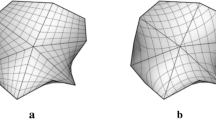Abstract
Developable surfaces are a subset of ruled surfaces, which can be mapped onto a plane without deformation. Due to this property, they have considerable relevance in several applications. In the medical area, regarding information visualization along sections of organs, they could be useful in clinical diagnosis. They have also industrial applications, including footwear and clothing industries, where three-dimensional (3D) designs are made from flat materials.
In this research, we consider the issue of approximating developable surfaces with segments of circular cones, with the aim of constructing splines that model interesting surfaces. Our emphasis will be in the odontological area. We present examples of “panoramic views” of curved sections of human jaw which contain information about all the dental pieces. Moreover, the process allows for the simultaneous display of these pieces in a flat surface, without metric distortion.
Access this chapter
Tax calculation will be finalised at checkout
Purchases are for personal use only
Similar content being viewed by others
Notes
- 1.
Actually for multiple root teeth, there might be more than one plane choices. These stem from the fact the best plane for clinical inspection could approximate any of the root pairs.
- 2.
If we have two adjacent contact elements \(({e}_{i},\tau_{i})\) and \(({e}_{i+1},\tau_{i+1})\), “jum** over a contact element” means omitting \(({e}_{i+1},\tau_{i+1})\) and considering instead \(({e}_{i},\tau_{i})\) and \(({e}_{i+2},\tau_{i+2})\).
References
Aumann, G.: A simple algorithm for designing developable Bézier surfaces. Comput. Aided Geom. Des. 20, 601–619 (2003)
Fuhs, W., Stachel, H.: Circular pipe connections. Comput. Graph. 12, 53–57 (1988)
Hersch, R., Figueiredo, O.: Parallel unfolding visualization of curved surfaces extracted from large three-dimensional volumes. J. Electr. Imaging 11, 423–433 (2002)
Hersch, R.,Gerlach, S.: Exploring anatomic structures with EPFL’s visible human web server. http://www.ibrarian.net/navon/page.jsp?paperid=13820841
Leopoldseder, S., Pottmann, H.: Approximation of developable surfaces with cone spline surfaces. Comput. Aided Des. 30, 571–582 (1998)
Paluszny, M.: Between developable surfaces and circular cone splines: curved slices of 3D volumes. Proc. SPIE, vol. 7964. Medical Imaging 2011: Visualization, image-guided procedures, and modeling, 1 Mar 2011
Saroul, L.: Surface extraction and flattening for anatomical visualization. PhD Thesis, École Polytechnique Fédérale de Lausanne, Faculté Informatique et Communications (2006)
Wikipedia The Free Encyclopedia: Visible human project. http://en.wikipedia.org/wiki/ Visible$_{–}$Human$_{–}$Project (2011). Accessed 18 Sept 2011
Wikipedia The Free Encyclopedia: Trilinear interpolation. http://en.wikipedia.org/wiki/ Trilinear$_{–}$interpolation (2011). Accessed 5 July 2011
Acknowledgments
We wish to thank José F. Ramírez Huaca for Fig. 11.
Author information
Authors and Affiliations
Corresponding author
Editor information
Editors and Affiliations
Rights and permissions
Copyright information
© 2015 Springer International Publishing Switzerland
About this paper
Cite this paper
González, C., Paluszny, M. (2015). Odontological Information Along Cone Splines. In: Tost, G., Vasilieva, O. (eds) Analysis, Modelling, Optimization, and Numerical Techniques. Springer Proceedings in Mathematics & Statistics, vol 121. Springer, Cham. https://doi.org/10.1007/978-3-319-12583-1_15
Download citation
DOI: https://doi.org/10.1007/978-3-319-12583-1_15
Published:
Publisher Name: Springer, Cham
Print ISBN: 978-3-319-12582-4
Online ISBN: 978-3-319-12583-1
eBook Packages: Mathematics and StatisticsMathematics and Statistics (R0)




